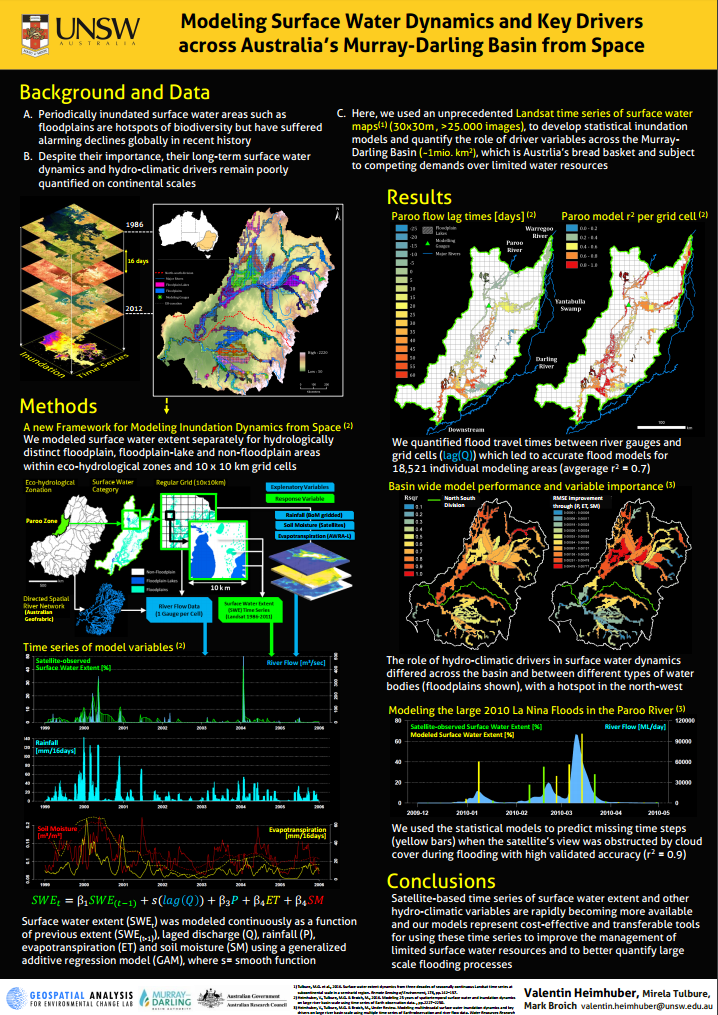Interview with Valentin Heimhuber, winner of the MSSANZ student poster prize at OzEWEX2016

 Valentin Heimhuber won the MSSANZ Student Poster Prize at the OzEWEX2016 workshop, for his poster explaining the use of satellite data for assessing environmental flows. Valentin is undertaking his PhD research with the Geospatial Analysis for Environmental Change lab at the University of New South Wales. OzEWEX editor Simon Walker interviewed Valentin about his research.
Valentin Heimhuber won the MSSANZ Student Poster Prize at the OzEWEX2016 workshop, for his poster explaining the use of satellite data for assessing environmental flows. Valentin is undertaking his PhD research with the Geospatial Analysis for Environmental Change lab at the University of New South Wales. OzEWEX editor Simon Walker interviewed Valentin about his research.
Simon: What gave you the idea for this study?
Valentin: My study is part of a larger Australian Research Council Linkage Project in collaboration with the Murray-Darling Basin Authority led by Dr Mirela Tulbure. As part of this project, our Geospatial Analysis for Environmental Change Lab is developing a new approach for assessing environmental flows using satellite data. A large component of this project was the development of a 26-year time series of surface water maps for the Murray-Darling Basin by applying machine learning image classification models to over 25 000 Landsat images.
Simon: So how did the work of your PhD contribute to the broader project?
Valentin: In my PhD, I developed a new framework for integrating this time series of surface water maps with time series of key hydro-climatic variables and in situ measurements on river flow, to obtain statistical inundation models for all rivers, floodplains and other type of wetland systems in the Murray-Darling Basin.
Simon: What aspect of the project appealed to you most?
Valentin: I have a background in water resources engineering and hydrodynamic modeling, but the large river basin scale along with the novel satellite data-driven approach made the decision easy for me to do my PhD on this truly exciting project.
Simon: What was your main finding?
Valentin: Based on our new framework, we were able to estimate flood travel times between river gauges and modeling cells from the satellite data. We were also able to generate accurate statistical inundation models for 18 521 individual modeling areas that together cover the entire Murray-Darling Basin. We used the models to quantify the role of river flow and hydro-climatic drivers such as local rainfall, evapotranspiration and soil-moisture in surface water dynamics across the river basin. We found that local climate conditions were more relevant in the northern compared to the southern basin and had the highest influence in the least regulated and most extended floodplains in the north-west. To put it simply, these models essentially allow us to track large floods through the entire river system over time and point out hotspot floodplain areas, where inundation extent and duration is largely influenced by local climate conditions in addition to inflow from the rivers.
Simon: How can the results be used in decision making?
Valentin: The statistical inundation models can predict surface water extent for cloud-affected Landsat observations or during the peak of floods. This allows a more detailed quantification of the inundation dynamics of large floods compared to existing approaches. The resulting information on the extent and duration of inundation from different river flow regimes could be used for improving environmental flow strategies across the Murray-Darling Basin.
Simon: What was the hardest part of your research?
Valentin: I am integrating and modeling multiple 26 year-long spatial time series over an area that is about 1 million km2 or twice the size of France. So the key challenge was to manage, process and model this large amount of data. Most remote sensing-based data sets come in different formats and resolutions and a lot of the work involved in my analysis was to write reproducible code for integrating and modeling the data using open source programming languages such as Python and R.
Simon: What advice can you give people wanting to do similar sort of research?
Valentin: During my PhD I quickly learned that we are currently experiencing the golden age of Earth observation and satellite remote sensing and that there is huge potential for changing the way we do hydrological sciences towards more integrated and global scale analyses. I believe that there is an exciting research project for everyone who is passionate about applying cutting edge satellite technology for improving the management of water and other natural resources.
Simon: Where do you think would be a good place to start?
Valentin: A good way to start would be to just browse the multitude of projects that are currently happening all around the world. OzEWEX would be a great starting point or check opportunities in our Geospatial Analysis for Environmental Change Lab where you can get a degree and learn cutting edge technical and research skills. I believe that as long as you are truly passionate about your own research topic, a successful outcome is pretty much guaranteed.
Simon: What are your own aspirations for the future?
Valentin: I would really like to become an ambassador for the usage of satellite technology for improving the management of water resources on a global scale. Global wetland areas continue to be lost at alarming rates and there is currently a new global boom in the development of large hydropower dams. This will put enormous pressure on remaining freshwater ecosystems. I believe that Earth observation combined with cutting-edge science can be the key for solving the freshwater problems of the future, but there is also still a large gap between scientific evidence and decision making.
Apart from doing good science, we also need to ensure that our findings make their way into the political decision making process, and eventually create a sustainable future for our water resources. I have been communicating this message to a variety of audiences as much as I can through a number of talks during my PhD and I would like to continue this communication and become a specialist on global scale applications of remote sensing in hydrology.
Simon: Thanks for your time.
Valentin: You’re welcome.

